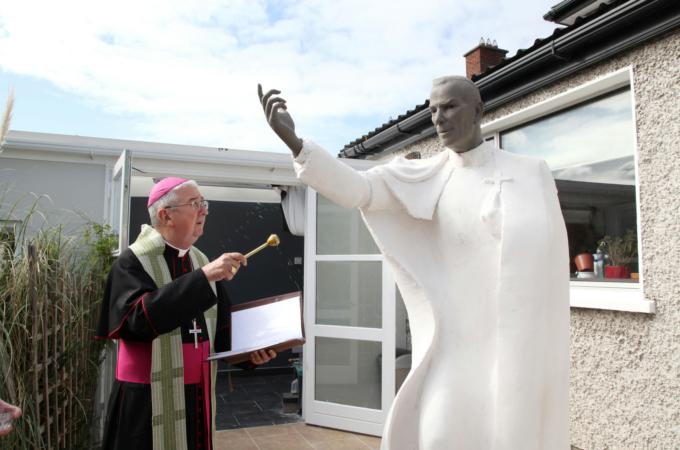Archbishop Sheen
Archbishop Fulton Sheen's legion of admirers can only hope his beatification, originally scheduled December 21 in his home diocese of Peoria and now postponed by the Vatican, will soon take place. The postponement was requested by what the diocese said were "a few members" of the U.S. bishops' conference. No reasons for the delay were given, and the diocese called Archbishop Sheen "a model of holiness and virtue."
Beatification -- formal recognition by the Church that someone is "blessed" -- is the last stage in the process leading to canonization, formal recognition as a saint. Like canonization, it requires authentication by the Holy See of a miracle performed at the intercession of the one beatified.
Archbishop Sheen's miracle was the healing in Peoria of an apparently stillborn infant whose heart did not beat for 61 minutes but started after his intercession was sought. Today, young James Fulton Engstrom is a healthy nine-year-old who likes chicken nuggets, "Star Wars," and riding his bike.
Following ordination as a priest in September, 1919, and studies in Louvain, Belgium, and Rome, Fulton Sheen taught theology and later philosophy at the Catholic University of America in Washington, D.C.
In early 1930, the National Council of Catholic Men invited him to launch a Sunday evening radio show called "The Catholic Hour." The response was so positive that he soon was the regular speaker, with an audience that eventually rose to 4 million and generated as many as 6,000 letters weekly from both Catholics and non-Catholics.
Then came television. In 1952, the Dumont network asked the recently named auxiliary bishop of New York to fill a half-hour in the Tuesday 8-9 p.m. time slot opposite comedian Milton Berle's enormously popular show on another network. It was assumed that Bishop Sheen's "Life Is Worth Living" would attract only a handful of viewers.
The assumption was wrong. By April the bishop, clad in episcopal robes and using neither teleprompter nor notes, was getting 8,500 letters a week. At the peak, he had 30 million viewers. The New York Times TV critic hailed the show as "remarkably absorbing." Time magazine put him on its cover and called him "perhaps the most famous preacher in the U.S., certainly America's best-known Roman Catholic priest." Receiving an Emmy, he thanked "my four writers -- Matthew, Mark, Luke and John."
He also wrote books, 73 of them, many still in print. He was famous, too, for his celebrity converts including writer Heywood Broun, playwright, congressperson and ambassador Clare Boothe Luce, former editor of the Communist Daily Worker Louis Budenz, musician Fritz Kreisler, and movie actress Virginia Mayo. An ardent anti-Communist since the 1930s, he was a notable Cold War figure but opposed the war in Vietnam. As national head of Propagation of the Faith, he raised some $200 million for foreign missions.
In 1966, at age 71, he was named Bishop of Rochester, N.Y. Although he aimed to be a Vatican II bishop, he was criticized for unilateral decision making and later attributed his problems to lack of experience heading a diocese. Upon retiring in 1971, he was named an archbishop. On December 9, 1979, he was found in his private chapel before the Blessed Sacrament, dead of heart failure at the age of 84.
In his posthumously published autobiography "Treasure in Clay," Archbishop Sheen acknowledged having faults, including vanity and a comfortable lifestyle.
"I consider everything waste except knowing Christ," he wrote.
- Russell Shaw is the author of more than twenty books. He is a consultor of the Pontifical Council for Social Communications and served as communications director for the U.S. Bishops.



















